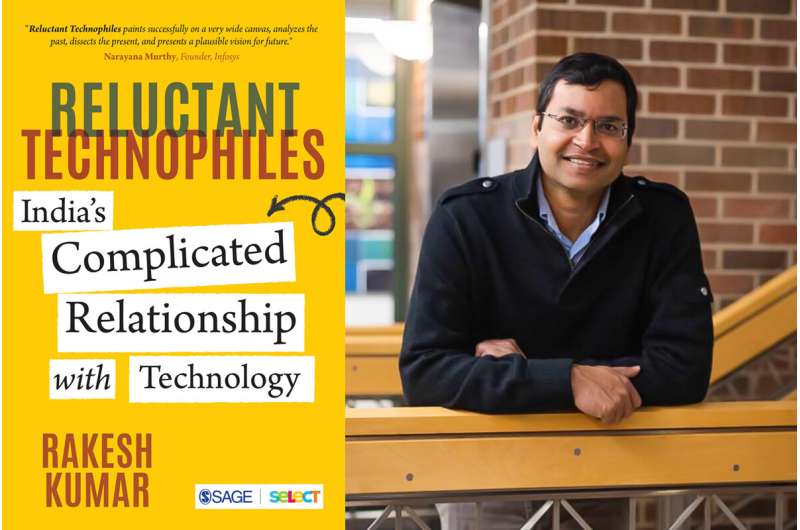
Technology is a big part of life in India. For example, street vendors and rickshawallahs use cellphones, the internet and Aadhar cards—12-digit identification numbers given to every citizen based on their biometric and demographic data. However, charismatic gurus and superstition still thrive in India. In the new book “Reluctant Technophiles: India’s Complicated Relationship with Technology,” University of Illinois Urbana-Champaign electrical and computer engineering professor Rakesh Kumar provides an account of India’s often contradictory relationship with technology. News Bureau physical sciences editor Lois Yoksoulian spoke with Kumar about these contradictions, and how India’s situation is both unique and universal.
Why is India such a good case study for examining how culture impacts technology?
India presents a good case study for several reasons. First, the problems that technology purports to address—poverty, inequality, access to health, education and infrastructure—are all glaringly present in India. At the same time, the challenges that modern technologies present—impact of automation on jobs, threat to democracy due to disinformation and compromised social harmony due to hate speech and radicalization—are particularly stark for India due to its large population, relatively volatile (or vibrant, if you prefer) democracy and often fragile social fabric.
India is an interesting case study also due to its contradictory attitudes toward technology. While there is a strong affinity toward using and benefiting from technology, technology is also often blamed for many things that go wrong in the country. This contradiction extends to the way people reconcile modern technology with some of the superstitious and religious elements deeply ingrained in the culture. It is also interesting how India’s technological past is often glorified, re-imagined and sometimes fabricated for national pride.
Finally, India serves as a good petri dish to see how effective technology-based solutions can be, given stubborn societal problems such as deep-rooted inequalities. For example, if a small fraction of a population enjoys access to technology and benefits from it, while others struggle to get their basic needs met, how useful can technology-based interventions be in that context?
Do Indian society and politics affect its attitude toward technology, or is it the other way around?
It’s both! A society decides its technological priorities. If you just looked through the history of technology in India, you would see that the focus on certain technology areas—computing, space and nuclear power—did not occur purely as a result of happenstance, but through deliberate policymaking. Fast forward to today, India’s biggest technology projects—unique digital ID to every Indian, seamless national digital-payment platforms and broadband access to every village, etc.—reflect the social and political priorities.
The impact of technology on society and politics is also clear. The use of social media to promote viewpoints, including politics, is rampant. Technology-based successes such as financial inclusion and direct subsidies have arguably helped political parties win elections. Online radicalization, disinformation and hate speech have had many unfortunate real-world consequences.
How is India’s relationship with technology affecting its economy and the global economy?
We sometimes forget that one out of five humans are Indian. So, choices that India makes for its economy affect the world. For a country like India with a large and growing young population, the strongest motive to adopt and develop technology is that it can help drive the economy and lift people out of poverty. As the cost of technology keeps falling, the fruits of innovation are becoming available to an ever-increasing number of people.
How can the lessons learned from India’s experiences be applied to all nations?
The key lesson of the book is that the benefits and challenges of technology depend on the unique context that it exists in—its history, inequalities and society, etc.
In the U.S., for example, we often blame technology for many things that go wrong in society. Challenges, such as the impact of automation on jobs, threat to democracy due to disinformation and compromised social harmony due to hate speech and radicalization, have been front and center for quite some time. Algorithmic bias is already a significant problem. Inequalities have been increasing, which has already started affecting outcomes from technology-based interventions. A deeper discourse on technology-society interaction will be helpful.
Citation:
How does society impact the benefits and challenges of technology? (2021, December 9)
retrieved 9 December 2021
from https://phys.org/news/2021-12-society-impact-benefits-technology.html
This document is subject to copyright. Apart from any fair dealing for the purpose of private study or research, no
part may be reproduced without the written permission. The content is provided for information purposes only.







More Stories
The Information Technology Era
The Main Functions of Computer Memory
Save Money by Investing in Industrial Computer Enclosures That Increase the Lifespan of Computers